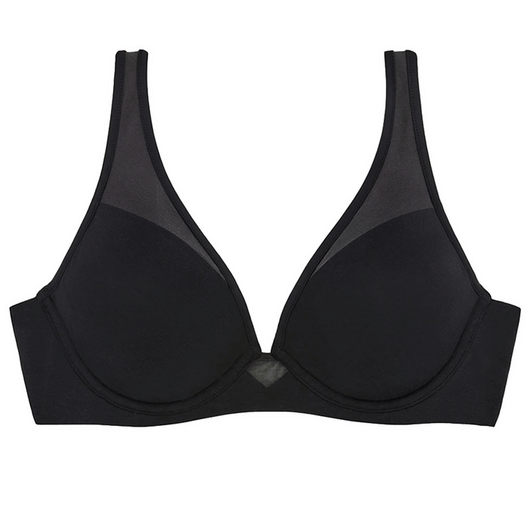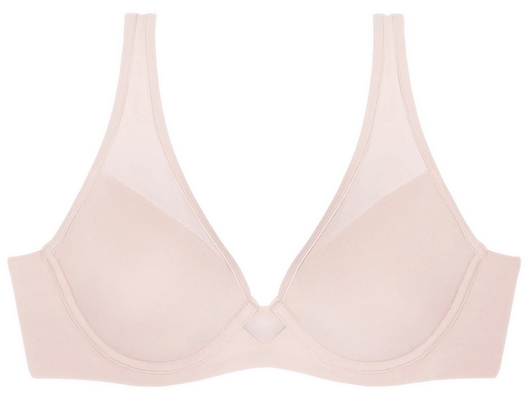As women’s clothing has become less voluminous and more revealing, our undergarments have had to follow suit.
While an old, full coverage bra with a high center is acceptable under a turtleneck or a crewneck, today’s more daring necklines require a different option. Enter the plunge bra.

Table of Contents
What is a Plunge Bra?
A plunge bra features demi cups and little coverage in the bra’s center where the cups connect.
This style of bra supports the breasts from the center, pushing them together and amplifying cleavage.
When you’re wearing a top or a dress with a plunging neckline, this is the bra that will give you the best support while remaining discreetly tucked away behind your clothes.

Features of a Plunge Bra
- Angled cups: Rather than cutting a straight line at the top of the cup, a plunge bra has angled cups that make it less visible under daring tops.
- No padding: Although a plunge bra is similar in form and function to a push-up bra, it does not usually include padding.
- Gentle lifting: Plunge bras do more than support your breasts under low-cut tops. They also offer a small amount of lift to make your cleavage and decolletage pop under your clothing. If you’re looking to add extra sex appeal to your outfit, choose a plunge bra over a simple strapless or triangle bra.
Styles of Plunge Bra
| Deep Plunge | Strapless Plunge | U Plunge | Plunge Push Up |
|---|---|---|---|
| Deeply scooped | No straps | The band is similar to a bustier | More padding than a traditional plunge |
| The band can extend under the sternum | The band extends lower than other strapless bras | More supportive on the sides | Amplifies your bust size |
| Perfect for deep v neck tops | Easy to wear with thin-strapped tops | More space between cups than traditional plunge bra | Pairs well with a sweetheart neckline |
Potential Fit Problems
- Wider set straps: A plunge bra might be more prone to slipping if your shoulders are narrow or slope more. Make sure your straps are tightened before you go out. If you still have problems with strap slippage, look for a bra with convertible straps and criss-cross them in the back.
- Extra space at the top of the cups: For women whose breasts are fuller toward the bottom, there can be gapping at the top of your plunge bra’s cups. If you have this problem, tighten the straps.
- Breast spillage: Since the plunge bra supports more from the side than the center, you run the risk of your cups running over. If you have softer breast tissue, try one of the bustier styles where the band sits under your breastbone.
- Not enough cleavage: If you have smaller breasts, saggy breasts, or wide-set breasts, a plunge bra might not offer the proper level of uplift. If you’re trying on multiple plunge bras and aren’t happy with the results, try a push-up plunge bra or another type that is lightly padded for additional lift.
How to Wear Your Plunge Bra
You probably won’t wear this bra for everyday outfits. But if you’re rocking a daring neckline, or you want some added cleavage, choose a plunge bra.
Before you buy, get a proper fitting to make sure you’re purchasing the correct size. Try on multiple styles and brands so you can find the best one for your body.
Once you’ve purchased your plunge bra, try it on with various tops and dresses to see how it looks.
Depending on how much fabric is on your chosen bra, it may still be visible on the sides and in the back of your outfit.
Use a multiway mirror to check out the fit on all sides and ensure that the bra achieves your desired silhouette.
A plunge bra is a must-have staple for any lingerie wardrobe.
This style keeps you lifted under tops with little room for chest support.
Many plunge bras are also frilly and sexy, so find one that you can pair with your favorite pair of panties to add some pizzazz to your outfit.





